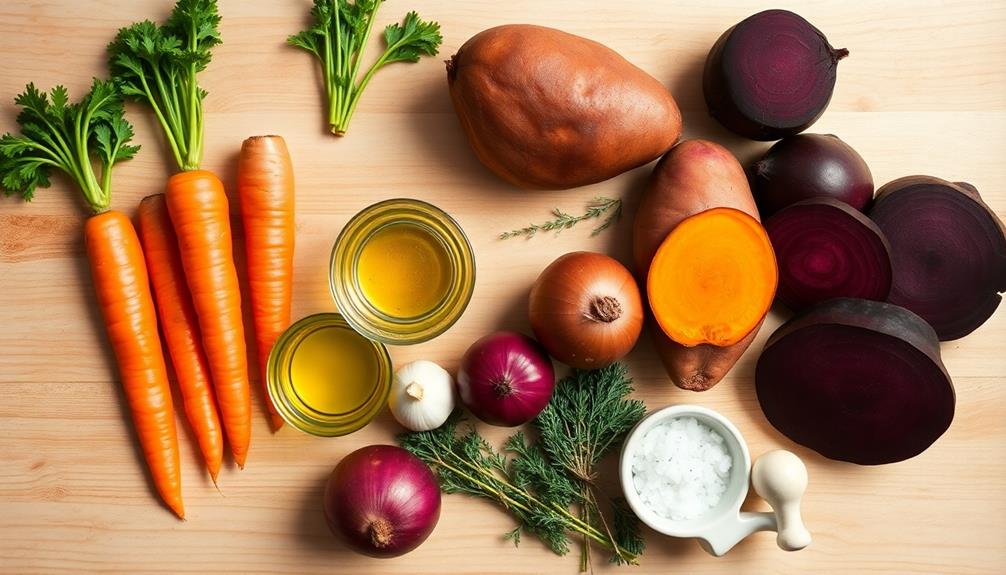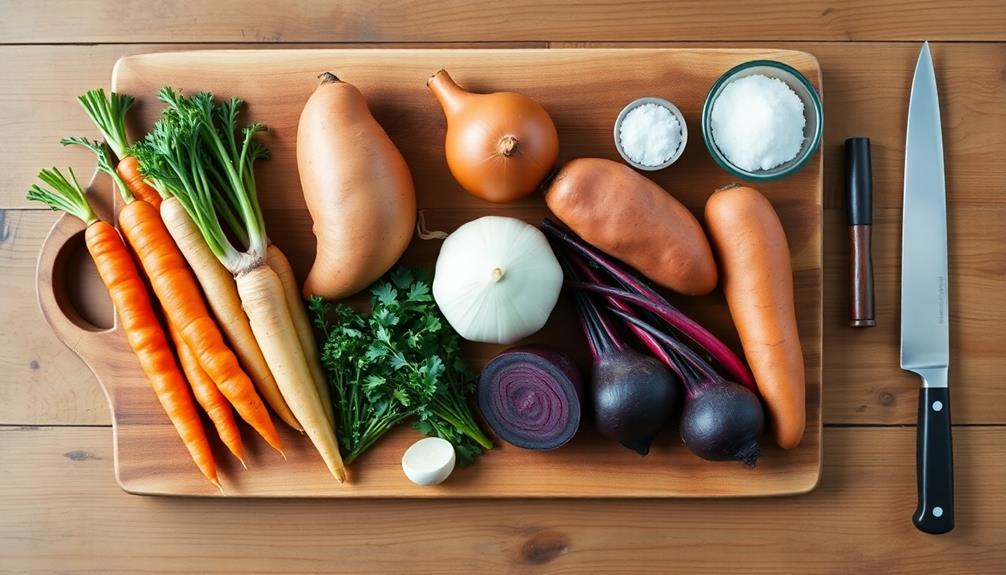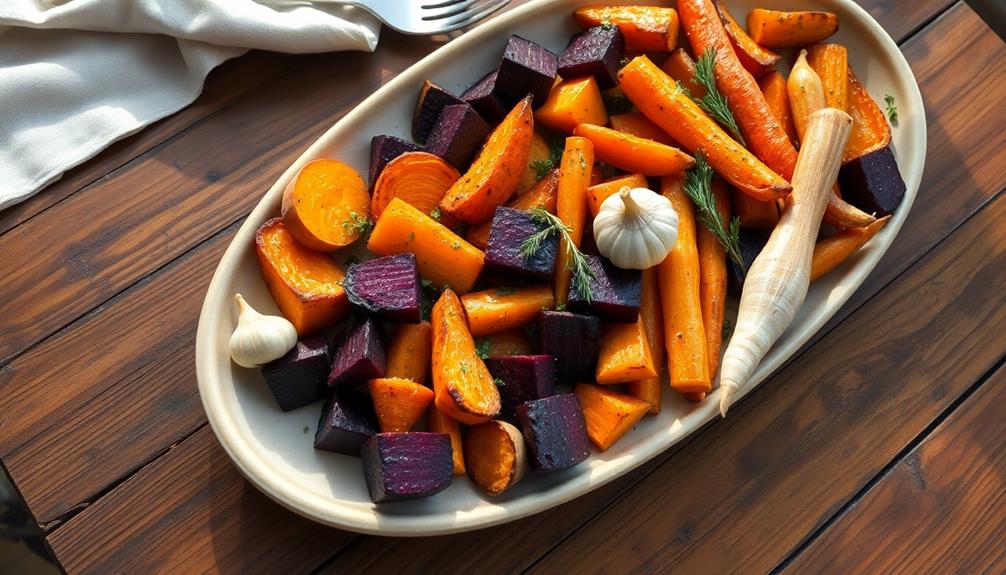Roasted root vegetable medley is a delicious and nutritious side dish that's perfect for any season. You'll love how easy it is to make! Start by preheating your oven to 425°F. Chop your favorite root veggies like carrots, parsnips, and sweet potatoes into uniform pieces. Toss them with olive oil, salt, pepper, and herbs. Spread the vegetables on a baking sheet and roast for 30-40 minutes, stirring halfway through. The result is a colorful mix of caramelized, tender vegetables with crispy edges. It's versatile, too – you can customize it with different spices or use it in various meals. There's so much more to discover about this tasty dish! For a sweeter twist, try adding a drizzle of honey to the vegetables before roasting for a honeyglazed recipe. The natural sweetness of the honey complements the earthy flavors of the root vegetables, creating a tantalizing combination. Whether you serve it as a side dish, toss it into a salad, or use it as a filling for a wrap, this roasted root vegetable medley will surely become a new favorite in your recipe repertoire.
Key Takeaways
- Roasted Root Vegetable Medley combines carrots, parsnips, sweet potatoes, red onions, and beets for a hearty side dish.
- Preheat oven to 425°F (218°C), chop vegetables uniformly, and toss with olive oil and seasonings before roasting.
- Spread vegetables in a single layer on a baking sheet and roast for 30-40 minutes, stirring halfway through.
- The dish offers nutritional benefits, including essential nutrients for growth and improved executive function development in children.
- Customizable recipe allows for different herbs, spices, or root vegetables based on preference and availability.
History
The practice of roasting root vegetables dates back centuries. You'll find that ancient civilizations often cooked these hearty veggies over open fires or in earthen ovens. They'd use whatever roots were available in their region, like turnips, carrots, and parsnips.
As cooking methods evolved, so did the ways people prepared root vegetables. In medieval times, you might've seen them roasted on spits or baked in clay ovens. By the 18th and 19th centuries, cast iron stoves became popular, making it easier to roast vegetables at home.
Today, you're likely to roast your root veggies in a modern oven. The basic idea hasn't changed much, though. You'll still cut them into pieces, toss them with oil and seasonings, and cook them until they're tender and caramelized.
What has changed is the variety of roots we use. Now, you can find exotic options like rutabagas, celeriac, and kohlrabi in many grocery stores. This gives you more choices to create your own unique roasted root vegetable medley.
Recipe
This hearty Roasted Root Vegetable Medley is a perfect side dish for fall and winter meals. The combination of sweet and savory flavors, along with the caramelized edges of the vegetables, creates a delightful taste experience that's both comforting and nutritious.
The beauty of this recipe lies in its versatility. You can easily customize it based on your preferences or what's available in your pantry. The key is to choose a variety of root vegetables with different colors, textures, and flavors to create a well-balanced dish.
- 2 medium carrots, peeled and cut into 1-inch chunks
- 2 medium parsnips, peeled and cut into 1-inch chunks
- 1 large sweet potato, peeled and cut into 1-inch cubes
- 1 medium red onion, cut into wedges
- 2 medium beets, peeled and cut into 1-inch cubes
- 3 tablespoons olive oil
- 2 tablespoons fresh thyme leaves
- 2 cloves garlic, minced
- 1 tablespoon balsamic vinegar
- Salt and freshly ground black pepper to taste
Preheat your oven to 425°F (220°C). In a large bowl, toss all the prepared vegetables with olive oil, thyme, garlic, balsamic vinegar, salt, and pepper until evenly coated.
Spread the vegetables in a single layer on a large baking sheet, making sure not to overcrowd them. Roast in the preheated oven for 35-45 minutes, stirring once halfway through, until the vegetables are tender and caramelized around the edges.
For best results, cut the vegetables into similar-sized pieces to ensure even cooking. If you're using beets, consider roasting them separately or wrapping them in foil to prevent their color from bleeding into the other vegetables.
Don't be afraid to experiment with different herbs and spices – rosemary, sage, or a sprinkle of smoked paprika can add interesting flavor dimensions to this versatile dish.
Cooking Steps
To start your roasted root vegetable medley, you'll need to preheat your oven to 425°F.
Next, chop your chosen vegetables into even chunks and toss them with oil and your favorite seasonings.
Step 1. Preheat Oven to 425°F

Before diving into the recipe, you'll need to preheat your oven to 425°F (218°C). This high temperature is crucial for roasting root vegetables, as it helps create a crispy exterior while keeping the inside tender.
It's important to give your oven enough time to reach this temperature, so turn it on before you start preparing the vegetables.
While your oven is heating up, you can begin washing and chopping your root vegetables. The hot oven will ensure that the vegetables cook evenly and develop a delicious caramelized flavor.
If you're using a convection oven, you might want to reduce the temperature by 25°F, as these ovens circulate hot air more efficiently.
Step 2. Chop Vegetables Into Chunks

With a sharp chef's knife in hand, it's time to transform your whole root vegetables into uniform chunks.
Start with carrots, peeling them first if you'd like, then cut them into 1-inch pieces. For parsnips, treat them like carrots, but remove any tough, woody cores. Slice potatoes into quarters or eighths, depending on their size. You'll want all your chunks to be roughly the same size so they cook evenly.
Next, tackle the onions. Cut off the top and root ends, peel away the outer layers, and chop them into wedges.
For beets, trim off the tops and bottoms, then peel and cut into 1-inch cubes. Be careful, as beets can stain your hands and cutting board. If you're using sweet potatoes, peel them and chop into 1-inch pieces like the other veggies.
Step 3. Toss With Oil and Seasonings

Now that your vegetables are chopped and ready, it's time to add flavor. In a large mixing bowl, combine your root vegetable chunks. Drizzle them with olive oil, using about 2 tablespoons for every 4 cups of vegetables.
Don't skimp on the oil, as it helps the veggies roast evenly and develop a crispy exterior. Butter is also a fantastic option to enhance the richness of the dish, offering a creamy flavor that complements the earthy tones of the vegetables; consider using a savory butter infusion for an added layer of taste.
Next, sprinkle on your favorite seasonings. Salt and pepper are must-haves, but don't stop there. Try adding dried herbs like rosemary, thyme, or oregano for an aromatic boost. A pinch of garlic powder or paprika can add depth to the flavors. If you're feeling adventurous, toss in some cumin or curry powder for a unique twist.
Use your hands to gently toss the vegetables, making sure each piece is coated with oil and seasonings. This hands-on approach ensures even distribution and lets you feel if you need more oil.
Once everything's well-coated, your root vegetables are ready for roasting. This simple step transforms plain veggies into a flavorful, caramelized dish that'll be the star of your meal.
Step 4. Arrange on Baking Sheet

Once your vegetables are thoroughly coated, it's time to prepare them for roasting. Grab a large baking sheet with raised edges to keep everything contained. You'll want to line it with parchment paper or aluminum foil for easy cleanup later.
Spread your coated vegetables across the baking sheet in a single layer. It's important not to overcrowd the pan, as this can lead to steaming instead of roasting. If you have too many vegetables, use a second baking sheet rather than piling them up.
Make sure there's a bit of space between each piece. This allows hot air to circulate around the vegetables, helping them brown evenly and develop that delicious roasted flavor.
If some vegetables are larger than others, place them towards the outer edges of the pan. The outer edges tend to get hotter, so this helps everything cook at the same rate.
For root vegetables that are round or oddly shaped, you might want to cut a small, flat surface on one side. This will help them sit steadily on the baking sheet and prevent rolling around during cooking.
Step 5. Roast for 30-40 Minutes

Preheated to 425°F (220°C), your oven is ready to transform those raw vegetables into caramelized delights.
Place the baking sheet with your arranged root vegetables into the hot oven. Set your timer for 30 minutes, but be prepared to roast for up to 40 minutes total.
During this time, the vegetables will undergo a magical transformation. The high heat will cause their natural sugars to caramelize, creating a sweet and nutty flavor. You'll notice the edges starting to brown and crisp up, while the insides become tender and soft.
About halfway through the cooking time, around the 15-20 minute mark, open the oven and give the vegetables a quick stir or flip. This helps ensure even cooking and browning on all sides. Use a spatula or tongs to carefully turn the pieces over.
Keep an eye on your vegetables as they near the end of the cooking time. They're done when they're golden brown and easily pierced with a fork. If some pieces are smaller, they might cook faster, so you can remove them earlier if needed.
Final Thoughts
After enjoying this delicious roasted root vegetable medley, you'll appreciate its versatility and simplicity. It's a dish that can be served as a side or even as a main course for vegetarians. You can easily customize it by adding your favorite herbs or spices to suit your taste.
Incorporating a variety of vegetables not only enhances the dish but also supports important aspects of child development, such as encouraging healthy eating habits and providing essential nutrients for growth and learning; this is vital for executive function.
Don't be afraid to experiment with different root vegetables, too. While we've used carrots, parsnips, and sweet potatoes, you could try beets, turnips, or rutabagas for variety.
Remember, the key to perfect roasting is cutting your vegetables into similar-sized pieces so they cook evenly.
This recipe is great for meal prep, as you can make a big batch and reheat it throughout the week. It's also a fantastic way to introduce more vegetables into your diet. The natural sweetness that comes from roasting makes these veggies appealing even to picky eaters.
Lastly, don't forget to save any leftovers. They're delicious cold in salads or warmed up and served with a fried egg for a hearty breakfast.
Enjoy your roasted root vegetable medley!
Frequently Asked Questions
Can I Substitute Sweet Potatoes for Regular Potatoes in This Recipe?
Yes, you can substitute sweet potatoes for regular potatoes in your recipe. They'll add a unique flavor and vibrant color to the dish. Just keep in mind that sweet potatoes may cook faster, so adjust your roasting time accordingly.
How Long Can I Store Leftover Roasted Root Vegetables?
You can store leftover roasted root vegetables in an airtight container in the fridge for up to 4-5 days. They'll stay fresh and tasty. For longer storage, freeze them for up to 3 months. Reheat before serving.
Are There Any Non-Root Vegetables That Work Well in This Medley?
You can definitely include non-root veggies in your medley. Try adding bell peppers, zucchini, or Brussels sprouts. They'll roast well alongside root vegetables, adding variety to your dish. Just adjust cooking times for more delicate options.
What's the Best Way to Reheat Roasted Root Vegetables?
To reheat roasted root vegetables, you'll get the best results using your oven. Preheat it to 400°F, spread the veggies on a baking sheet, and warm them for 5-10 minutes. They'll regain their crispy exterior and tender interior.
Can I Prepare the Vegetables in Advance and Roast Them Later?
You can definitely prep your veggies ahead of time. Just peel, chop, and store them in an airtight container in the fridge for up to 24 hours. When you're ready, season and roast them as usual.









